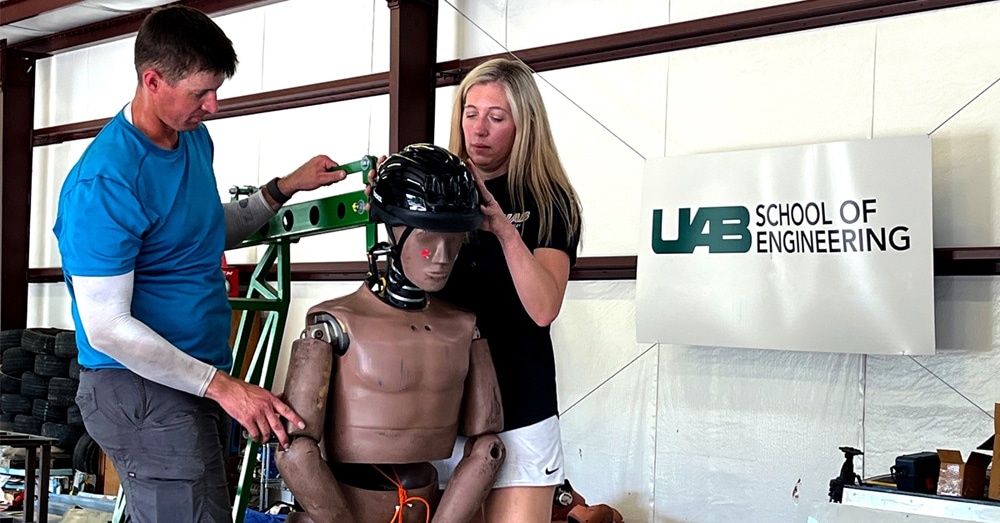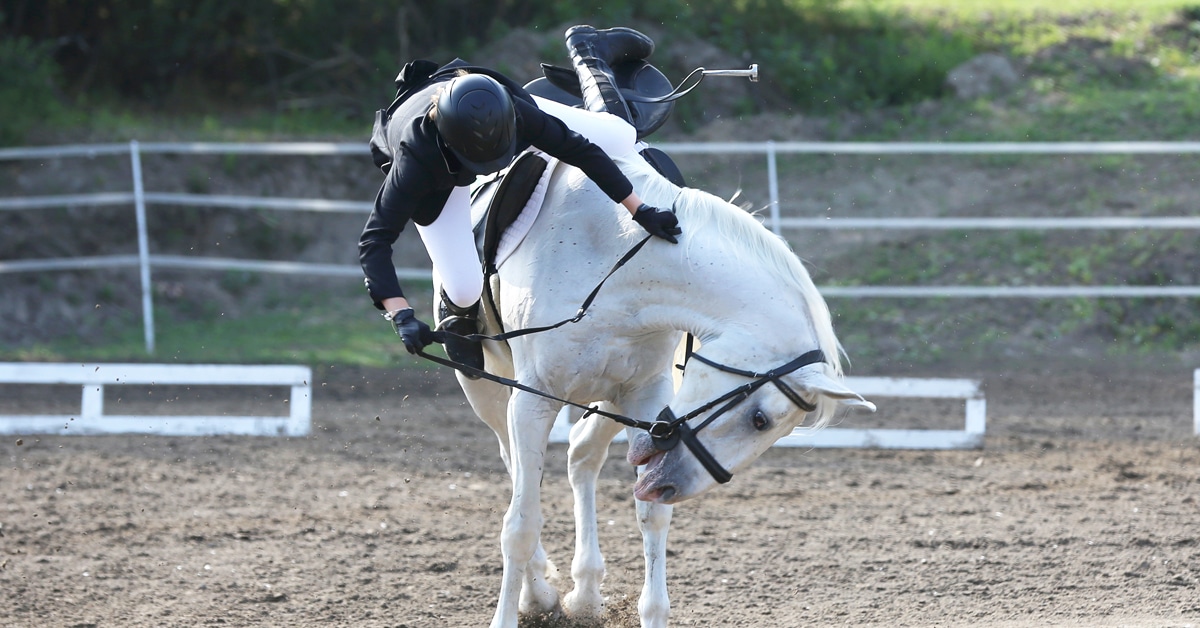The results of two studies on the effect of equestrian helmets and terrain on head and neck injuries were presented at the 6th International Consensus Conference on Concussion in Sport, October 27-29 in Amsterdam, The Netherlands. The conference was organized by the International Olympic Committee and sponsored by the FEI, Fédération Internationale de Football Association, World Rugby, International Ice Hockey Federation and Fédération Internationale de l’Automobile.
Researcher Sara Gould, Associate Professor at the Department of Orthopedics, Division of Sports Medicine at the University of Alabama in Birmingham and her team from the UAB Marnix E. Heersink School of Medicine conducted the studies using test dummies. One study looked at rotational velocity during head impact using a standard equestrian helmet made from a polycarbonate shell over expanded polystyrene foam compared to newer technology known as the Multi-directional Impact Protection System (MIPS).
In this study, the test dummy was launched from an accelerated sled at 13.0 mph which came to an abrupt stop at the end of the track which propelled the dummy off the holding device with a tripping mechanism induced angular momentum. The team measured peak deceleration, duration of peak deceleration, peak rotational velocity and duration of peak rotational velocity.
Brain tissue is not highly compressible, so it can withstand compressive forces that result from linear acceleration. However, rotational acceleration induces shear forces, which are more likely to injure the brain. Shearing forces are forces that push one part of the body in one direction and another part of the body in the opposite direction. Because the brain is not able to absorb these forces well, rotational acceleration of the head is a leading cause of brain injury.
“This novel method of testing takes into account the tremendous loading placed on the neck and head through the angular momentum of the body itself, particularly in a fall from a height, such as a fall from a horse,” said Gould. “Our testing method did not detect a reduction in rotational velocity with MIPS technology compared to traditional helmets. Information gleaned from studies of this nature will contribute to the continuing improvement in helmet technology.”
In a second test to determine whether terrain affected helmet performance, a test dummy equipped with a traditional helmet was launched from an accelerated sled with the same sudden stop and tripping mechanism. The team tested the helmet’s performance on deceleration and rotational velocity upon impact with three different surfaces: sod, sand, and a sand/fiber mixture.
“All surfaces were similar in deceleration values,” Gould said. “Sand and sand-plus-fiber surfaces resulted in significantly lower rotational velocities upon helmet impact compared to sod, which could have implications for best practices in the construction of equestrian venues.”
HorseSport fielded some questions to Gould and her co-author on the project, Kevin Schrum, to better understand the results and implications of this ground-breaking research.
Please explain ‘rotational velocity’ in terms of what it would actually look like as a rider came off a horse and hit the ground.
Schrum: Rotational velocity is how quickly an object rotates relative to a point. In the context of a rider, it’s similar to the end of a whip. When a whip cracks, it is because the loop at the end accelerates with rotational velocity until it creates a sonic boom. A rider’s body is like the length of the whip, and the head is like the loop at the end. In our experiment, we were interested in how fast the head rotates relative to the ground, especially after it recoils from the impact.
Gould: Our testing method uses a life-size, human form anthropomorphic test device (ATD or dummy). This is really important because other testing mechanisms use an isolated headform*. From previous experimental models we know that mobile heads (as attached to a neck and body) more closely replicate real-life forces, as would occur when a rider falls off a horse. Also, the mobile head models seem to be more susceptible to concussive forces than fixed-head models of testing.
(*Ed. note: Virginia Tech has recently released their annual Helmet Ratings based on the STAR testing system which uses impact tests on a headform.)

The study’s testing apparatus was designed by Gould in collaboration with her co-author on the project, Kevin Schrum, Ph.D., P.E.
The article says that the MIPS system didn’t have an effect on rotational velocity – why is that particular variable significant? Does angular momentum increase the impact speed/load?
Schrum: With the weight of the dummy behind the head, as it rotates, the angular momentum increases both impact speed and load. The speed is increased because the regular velocity experienced by the head is a combination of linear velocity and tangential velocity (which comes from rotation). Also, without the weight of the body behind the head, the head would simply bounce off the surface without much resistance. The body forces a much more severe response.
Gould: I want to point out that we didn’t find that the MIPS performed better than regular helmets on our testing, but our testing was limited in the number of times we performed it. So it’s possible there would have been a difference, if we had performed more tests. The really interesting thing to me was that one of the regular inexpensive foam helmets DID perform significantly better, even on the limited number of tests.
Rotational velocity is important because brain tissue is very susceptible to injury as a result of rotational acceleration, which is the angular rate of change per second. Peak rotational velocity provides both a measure of the magnitude of the rotational acceleration and its duration. These helmeted impacts occur in well under a tenth of a second. Brain tissue is not highly compressible, so it can withstand compressive forces that result from linear acceleration. However, rotational acceleration induces shear forces, which are more likely to injure the brain. Shearing forces are forces that push one part of the body in one direction and another part of the body in the opposite direction. Because the brain is not able to absorb these forces well, rotational acceleration of the head is a leading cause of brain injury.
In MIPS products and other helmet types, what could improve rotational velocity reduction in terms of helmet design?
Schrum: Again, we did not conclude that the MIPS product was ineffective; we found that less expensive options were potentially as effective. However, our prior research and experience have shown that separating the initial impact with the helmet from the rotation of the head is an excellent way to mitigate the severity of these collisions. If the helmet is rotating but the head is not during the period of maximum loading, then the head will not experience any of the debilitating shear forces in the brain. MIPS allows for 10 to 15 mm of movement [because of a low-friction layer inside the helmet]. If the time duration of the peak loading occurs before that limit is reached, then the MIPS will have done a great job. So to answer your question, the available stroke is not the only consideration. Designers must also consider how long it takes for the movement to be realized.
Was anything of particular interest/surprising/newsworthy to you presented at the International Consensus Conference on Concussion in Sport in Amsterdam?
Gould: One thing I found surprising about the information presented at the conference was the lack of data on pediatric mild traumatic brain injury (specifically ages 5-12 years). The ratio of head-to-body surface area is really different between kids this age and adults, so when we’re looking at the recommendations, there’s not much evidence to go on. From a helmet-testing perspective, this underscores the importance of using pediatric-sized ATD’s in the future, so that we can test and account for the different forces conferred by the different head-to-body ratios and design safer helmets for kids and adults.

